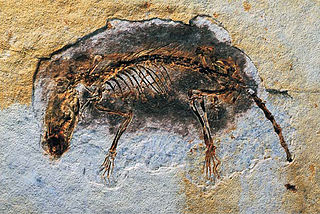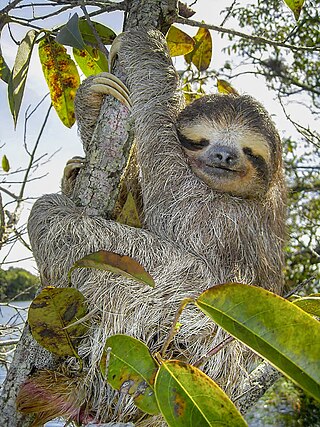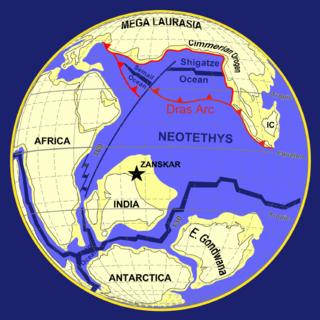
Marsupials are a diverse group of mammals belonging to the infraclass Marsupialia. They are natively found in Australasia, Wallacea, and the Americas. One of the defining features of marsupials is their unique reproductive strategy, where the young are born in a relatively undeveloped state and then nurtured within a pouch on their mother's abdomen.

Multituberculata is an extinct order of rodent-like mammals with a fossil record spanning over 130 million years. They first appeared in the Middle Jurassic, and reached a peak diversity during the Late Cretaceous and Paleocene. They eventually declined from the mid-Paleocene onwards, disappearing from the known fossil record in the late Eocene. They are the most diverse order of Mesozoic mammals with more than 200 species known, ranging from mouse-sized to beaver-sized. These species occupied a diversity of ecological niches, ranging from burrow-dwelling to squirrel-like arborealism to jerboa-like hoppers. Multituberculates are usually placed as crown mammals outside either of the two main groups of living mammals—Theria, including placentals and marsupials, and Monotremata—but usually as closer to Theria than to monotremes. They are considered to be closely related to Euharamiyida and Gondwanatheria as part of Allotheria.

Placental mammals are one of the three extant subdivisions of the class Mammalia, the other two being Monotremata and Marsupialia. Placentalia contains the vast majority of extant mammals, which are partly distinguished from monotremes and marsupials in that the fetus is carried in the uterus of its mother to a relatively late stage of development. The name is something of a misnomer, considering that marsupials also nourish their fetuses via a placenta, though for a relatively briefer period, giving birth to less-developed young, which are then nurtured for a period inside the mother's pouch. Placentalia represents the only living group within Eutheria, which contains all mammals that are more closely related to placentals than they are to marsupials.

Eomaia is a genus of extinct fossil mammals containing the single species Eomaia scansoria, discovered in rocks that were found in the Yixian Formation, Liaoning Province, China, and dated to the Barremian Age of the Lower Cretaceous about 125 million years ago. The single fossil specimen of this species is 10 centimetres (3.9 in) in length and virtually complete. An estimate of the body weight is 20–25 grams (0.71–0.88 oz). It is exceptionally well-preserved for a 125-million-year-old specimen. Although the fossil's skull is squashed flat, its teeth, tiny foot bones, cartilages and even its fur are visible.

Eutheria, also called Pan-Placentalia, is the clade consisting of placental mammals and all therian mammals that are more closely related to placentals than to marsupials.

Metatheria is a mammalian clade that includes all mammals more closely related to marsupials than to placentals. First proposed by Thomas Henry Huxley in 1880, it is a more inclusive group than the marsupials; it contains all marsupials as well as many extinct non-marsupial relatives. It is one of two groups placed in the clade Theria alongside Eutheria, which contains the placentals. Remains of metatherians have been found on all of Earths continents.

Protungulatum is an extinct genus of eutherian mammals within extinct family Protungulatidae, and is possibly one of the earliest known placental mammals in the fossil record, that lived in North America from the Late Cretaceous to early Paleocene.

Cimolestes is a genus of early eutherians with a full complement of teeth adapted for eating insects and other small animals. Paleontologists have disagreed on its relationship to other mammals, in part because quite different animals were assigned to the genus, making Cimolestes a grade taxon of animals with similar features rather than a genus of closely related ones. Fossils have been found in North America, South America, Europe and Africa. Cimolestes first appeared during the Late Cretaceous of North America. According to some paleontologists, Cimolestes died out at the start of the Paleocene, while others report the genus from the early Eocene.
Maelestes is a prehistoric shrew-like mammal discovered in 1997 in the Gobi Desert. The animal lived in the late Cretaceous Period, around 71–75 million years ago, and was a contemporary of dinosaurs such as Velociraptor and Oviraptor. According to some scientists, the discovery and analysis of this species suggests that true placental mammals appeared near the time the non-avian dinosaurs became extinct 66 million years ago, not much earlier in the Cretaceous as thought by others. However, the presence of an epipubic bone, among other characteristics, place it as a non-placental eutherian.

Dryolestida is an extinct order of mammals, known from the Jurassic and Cretaceous. They are considered basal members of the clade Cladotheria, close to the ancestry of therian mammals. It is also believed that they developed a fully mammalian jaw and also had the three middle ear bones. Most members of the group, as with most Mesozoic mammals, are only known from fragmentary tooth and jaw remains.

Leptictida is a possibly paraphyletic extinct order of eutherian mammals. Their classification is contentious: according to cladistic studies, they may be (distantly) related to Euarchontoglires, although they are more recently regarded as the first branch to split from basal eutherians. One recent large-scale cladistic analysis of eutherian mammals favored lepictidans as close to the placental crown-clade; and several other recent analyses that included data from Cretaceous non-eutherian mammals found Leptictis to belong to the superorder Afrotheria.
Deccanolestes is a scansorial, basal Euarchontan from the Late Cretaceous (Maastrichtian) and Paleocene Intertrappean Beds of Andhra Pradesh, India. It may be closely related to Sahnitherium. Deccanolestes has been referred to Palaeoryctidae in the past, but recent evidence has shown that it is either the most basal Euarchontan, as the earliest known Adapisoriculid, or as a stem-afrotherian.

Paratheria is an obsolete term for a taxonomic group including the xenarthran mammals and various groups thought to be related to them. It was proposed by Oldfield Thomas in 1887 to set apart the sloths, anteaters, armadillos, and pangolins, usually classified as placentals, from both marsupial and placental mammals, an arrangement that received little support from other workers. When teeth of the extinct gondwanathere mammals were first discovered in Argentina in the 1980s, they were thought to be related to xenarthrans, leading to renewed attention for the hypothesis that xenarthrans are not placentals. However, by the early 1990s, gondwanatheres were shown to be unrelated to xenarthrans, and xenarthrans are still considered to be placentals.

Juramaia is an extinct genus of a therian mammal, possibly a very basal eutherian mammal, known from the Late Jurassic or Early Cretaceous deposits of western Liaoning, China. It is a small shrew-like mammal weighing around 15–17 grams (0.53–0.60 oz).
Afrodon is an extinct genus of eutherians in the family Adapisoriculidae. Its type species is Afrodon chleuhi, known from the late Palaeocene of Morocco. The other known species are Afrodon germanicus from the late Palaeocene of Germany and France, Afrodon tagourtensis from the early Eocene of Morocco, Afrodon ivani from the late Palaeocene of Spain, and Afrodon gheerbranti from the early Paleocene of Belgium. Its range spread from the Cernaysian to the Grauvian in the European land mammal ages.

Bustylus is an extinct genus of eutherians in the family Adapisoriculidae. It was described by Emmanuel Gheerbrandt and Russell in 1991, and the type species is B. cernaysi, described from the late Paleocene of Cernay, France, and possibly also from Germany. Gheerbrandt later redescribed the species Peradectes marandati as a species of Bustylus. A third species, B. folieae, was described from the early Paleocene of Belgium by Eric De Bast, Bernard Sigé and Thierry Smith in 2012. B. folieae was named in honour of Dr. Annelise Folie.
The Conglomérat de Cernay is a geologic formation in Champagne-Ardenne, northern France. It preserves fossils dating back to the Thanetian stage of the Paleocene period. The lizard Cernaycerta and placental mammal Bustylus cernaysi are named after the formation.

Insular India was an isolated landmass which became the Indian subcontinent. Across the latter stages of the Cretaceous and most of the Paleocene, following the breakup of Gondwana, the Indian subcontinent remained an isolated landmass as the Indian Plate drifted across the Tethys Ocean, forming the Indian Ocean. The process of India's separation from Madagascar first began 88 million years ago, but complete isolation only occurred towards the end of the Maastrichtian, a process that has been suggested to be the creation of the Deccan Traps. Soon after, the land mass moved northward rather quickly, until contact with Asia was established 55 million years ago. Even then, both landmasses did not become fully united until around 35 million years ago, and periods of isolation occurred as recently as 24 million years ago.

Zalambdalestidae is a clade of Asian eutherians occurring during the Cretaceous. Once classified as Glires, features like epipubic bones and various cranial elements have identified these animals as outside of Placentalia, representing thus a specialised clade of non-placental eutherians without any living descendants, and potentially rather different from modern placentals in at least reproductive anatomy.

Gypsonictops is an extinct genus of leptictidan mammals of the family Gypsonictopidae, which was described in 1927 by George Gaylord Simpson. Species in this genus were small mammals and the first representatives of the order Leptictida, that appeared during the Upper Cretaceous.



















